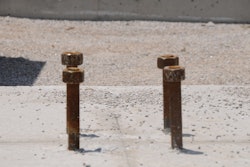It’s frustrating for concrete contractors to be held responsible for alleged defects discovered by owners’ representatives. It’s especially frustrating when owner’s reps search specifications and find a requirement that, to them, is the “smoking gun” needed to prove the contractors’ culpability and thus, establish their guilt.
Consider this scenario: You’re placing a concrete slab on metal decking in December. Ambient temperature is 25 degrees Fahrenheit and rising. A mixed concrete temperature is 60 degrees Fahrenheit and in-place temperature is maintained above 55 degrees Fahrenheit for three days with insulated blankets. After the blankets are removed, there are no cracks. Three months later the owner’s rep notices cracks in the deck. You say shrinkage and temperature cracks are normal for this kind of construction and produce several references to back your position. But the rep isn’t buying it. You’re guilty. After a few weeks of researching the specification, he points to Section 5. 3.2.1.b, Cold Weather, in “Specifications for Structural Concrete (ACI 301-10),” which requires the following: “Unless otherwise permitted do not place concrete in contact with surfaces less than 35 degrees Fahrenheit.” Surfaces in your case include metal decking, reinforcement, and embedments. Now for the smoking gun. An hour before the placement, the owner’s rep had used an infrared thermometer and noted in his report the temperature of the reinforcement and metal deck was 33 degrees Fahrenheit. Hence, he decides the deck was too cool, you didn’t comply with the specifications, and that’s the reason for the cracking—even though the cracking occurred three months after the deck placement. You’re guilty.
Or how about this? You’ve just finished placing concrete for a parking structure for which specifications required a maximum water-to-cementitious-materials ratio (w/cm) of 0.40 and a minimum strength of 5,000 psi, based on durability concerns. The average compressive strength for all concrete tests was 6,140 psi. But there is again a concern with some random cracking over the entire deck. In studying the delivery tickets for 30 loads of concrete to search for clues, the owner’s rep finds that two truckloads of concrete had w/cms of 0.41 and 0.43 as a result of a one-time addition of water at the jobsite because the slump was below a minimum limit. The concrete producer’s on-site quality control technician noted the amount of water added and that test cylinders were cast after the water addition. Another example of a smoking gun. In spite of the acceptable strength tests, which are probably a better indicator of w/cm than batch tickets and records of water added at the jobsite, he concludes that not only are you responsible for the cracking of the entire deck, but now the long-term durability of all the deck is questionable. So you’re guilty and responsible for all 30 of the trucks even though water was added to only two.
In both cases, the evidence is circumstantial at best. But in the court of law on the construction site, circumstantial evidence is often all that’s needed to establish guilt and force the contractor to perform expensive repairs or provide additional protection based on an alleged potential durability problem. Can contractors fight back? Sure they can. But if they do the math, it often costs less to just buckle under and spend some money they hadn’t planned on. In cases much more complex than the two described, filing a claim and then fighting a legal battle to win the case may involve hiring a lawyer and one or more expert witnesses. Adding in the lost productivity and opportunity time as result of producing documents, giving depositions, and perhaps testifying in court, the costs can easily run to more than $100,000. So unless the cost of fixing the problem exceeds $100,000 it makes little sense to follow this route.
There’s one other key factor that discourages contractors from pleading not guilty. It’s called retainage and it is a powerful weapon owners can use in forcing contractors to repair alleged defects. When it might cost $20,000 to repair the cracks in that concrete slab, but the owner is holding $200,000 of your retainage, the math gets even simpler. Just do the repairs and get at least some of your money owed. Call it legalized extortion if you want, but it exists on most jobs.
When there is an alleged defect and a specification noncompliance is identified, the two must be correlated. A root cause analysis should be performed to determine if the specification noncompliance is the cause of the alleged defect. If that root cause is removed, the problem goes away. Without this analysis, circumstantial evidence leads to prosecution and conviction.



















